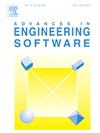在Abaqus和MSC中设计牵引复合层压板的工具。Patran / Nastran
IF 5.7
2区 工程技术
Q2 COMPUTER SCIENCE, INTERDISCIPLINARY APPLICATIONS
引用次数: 0
摘要
具有曲线纤维路径的牵引复合材料在轻量化结构中提供了增强的机械性能。然而,缺乏用于牵引复合结构的商业设计工具限制了其在实际应用中的设计创新。本文介绍了一个用户友好的高级可定制复合材料(DATC)设计工具,在两个广泛使用的商业有限元(FE)软件包Abaqus和MSC.Patran/Nastran中提供了一个集成的设计框架。DATC提供了一个图形用户界面(GUI)来连接多尺度板建模、FE建模、机器学习(ML)建模和设计优化。GUI通过管理所有设计配置和与几个外部代码交互来简化设计过程。多尺度建模程序SwiftComp基于转向纤维角度计算有效板刚度。ML模块训练高效的代理模型作为FE模型的替代,以降低计算成本。优化模块采用开源代码Dakota,迭代执行有限元分析,更新设计变量,多尺度板建模和优化。通过对三个双向复合结构的实例分析,论证了数据控制系统的用户友好性和适应性。本文章由计算机程序翻译,如有差异,请以英文原文为准。
Design tool for tow-steered composite laminates in Abaqus and MSC.Patran/Nastran
Tow-steered composites with curvilinear fiber paths offer enhanced mechanical performance in lightweight structures. However, the absence of commercial design tools for tow-steered composite structures limits innovation in their design for real-world applications. This paper introduces a user-friendly Design tool for Advanced Tailorable Composites (DATC), providing an integrated design framework in two widely used commercial finite element (FE) software packages, Abaqus and MSC.Patran/Nastran. DATC offers a graphical user interface (GUI) to connect multiscale plate modeling, FE modeling, machine learning (ML) modeling, and design optimization. The GUI streamlines the design process by managing all design configurations and interacting with several external codes. The multiscale modeling code SwiftComp calculates effective plate stiffness based on the steering fiber angles. The ML module trains efficient surrogate models as an alternative to FE models to reduce computational costs. The optimization module employs the open-source code Dakota to iteratively perform FE analysis with updated design variables, multiscale plate modeling, and optimization. The paper demonstrates the user-friendliness and adaptability of DATC through three case studies of tow-steered composite structures.
求助全文
通过发布文献求助,成功后即可免费获取论文全文。
去求助
来源期刊

Advances in Engineering Software
工程技术-计算机:跨学科应用
CiteScore
7.70
自引率
4.20%
发文量
169
审稿时长
37 days
期刊介绍:
The objective of this journal is to communicate recent and projected advances in computer-based engineering techniques. The fields covered include mechanical, aerospace, civil and environmental engineering, with an emphasis on research and development leading to practical problem-solving.
The scope of the journal includes:
• Innovative computational strategies and numerical algorithms for large-scale engineering problems
• Analysis and simulation techniques and systems
• Model and mesh generation
• Control of the accuracy, stability and efficiency of computational process
• Exploitation of new computing environments (eg distributed hetergeneous and collaborative computing)
• Advanced visualization techniques, virtual environments and prototyping
• Applications of AI, knowledge-based systems, computational intelligence, including fuzzy logic, neural networks and evolutionary computations
• Application of object-oriented technology to engineering problems
• Intelligent human computer interfaces
• Design automation, multidisciplinary design and optimization
• CAD, CAE and integrated process and product development systems
• Quality and reliability.
 求助内容:
求助内容: 应助结果提醒方式:
应助结果提醒方式:


